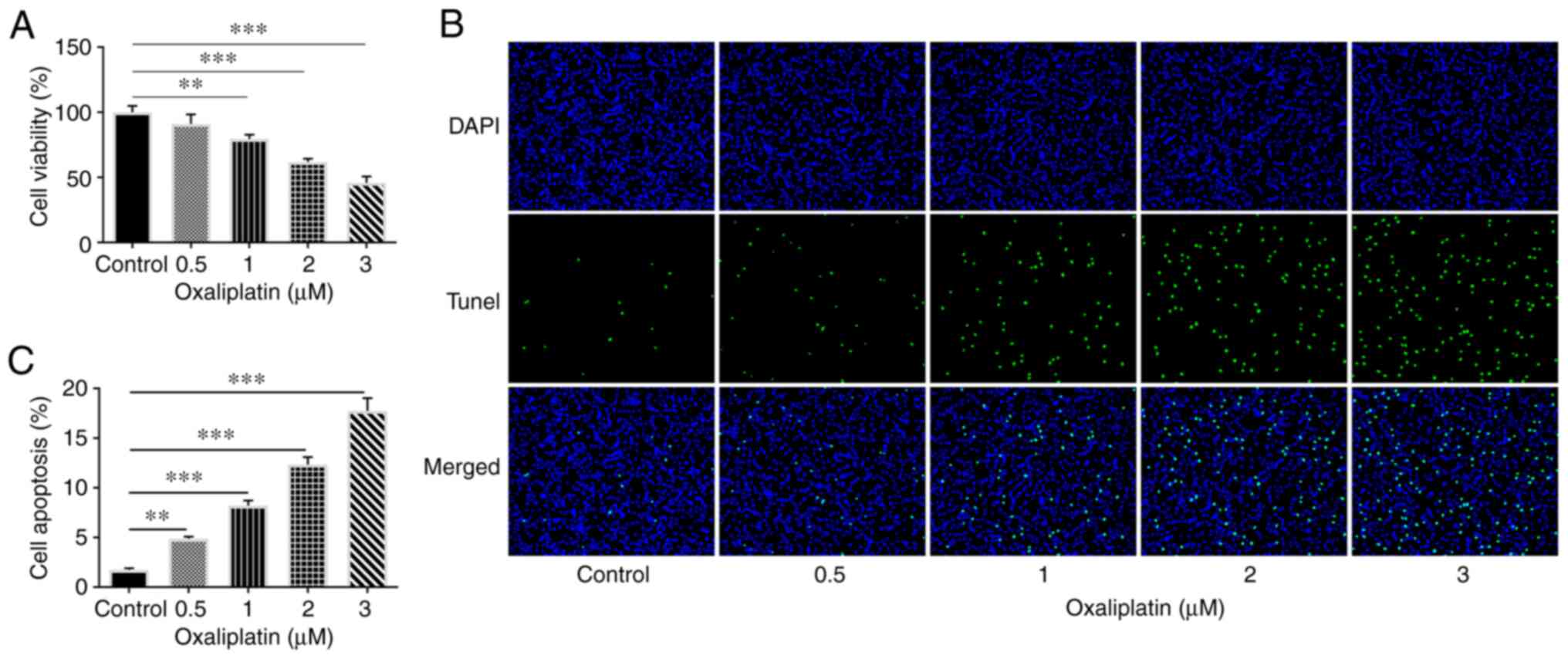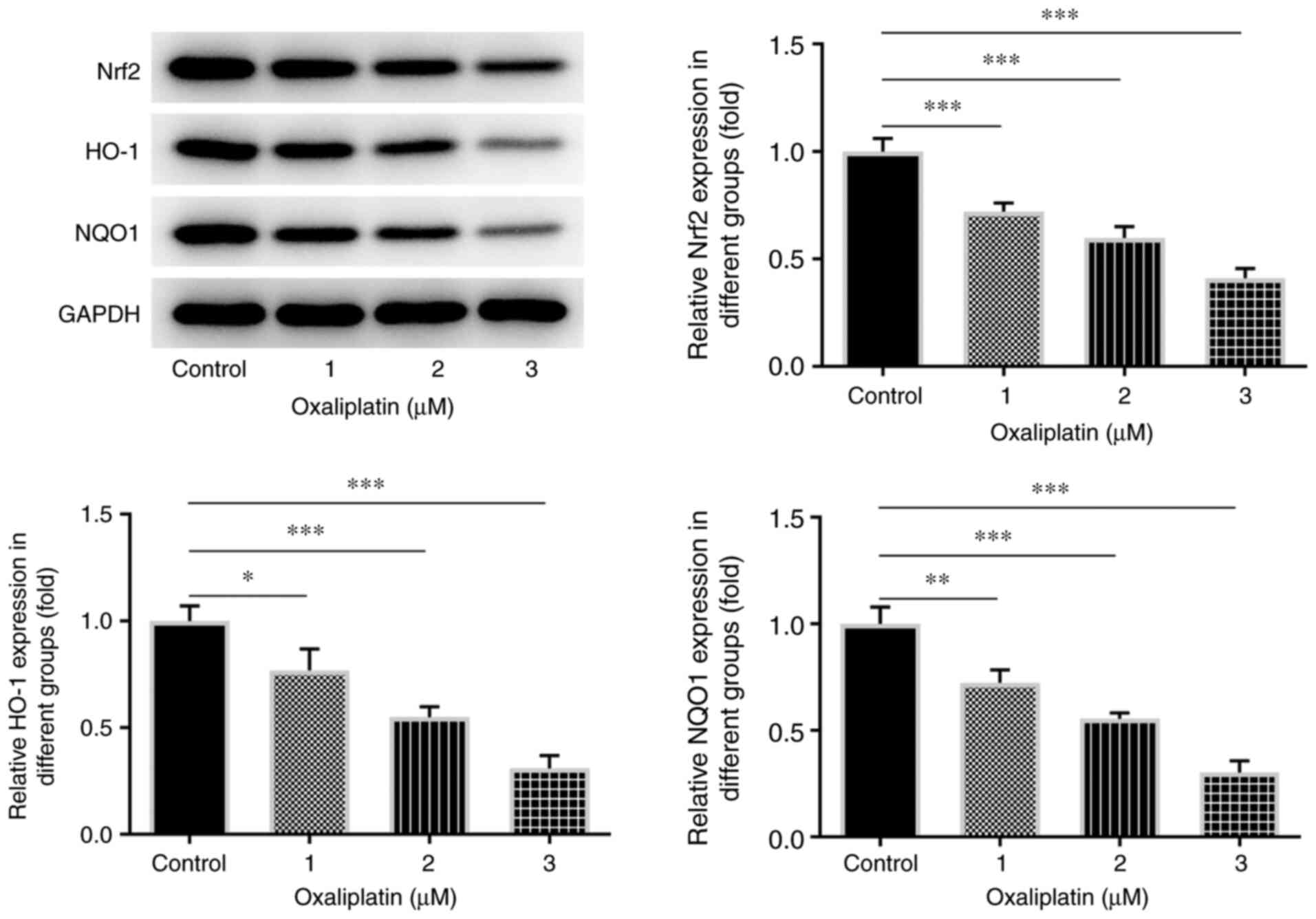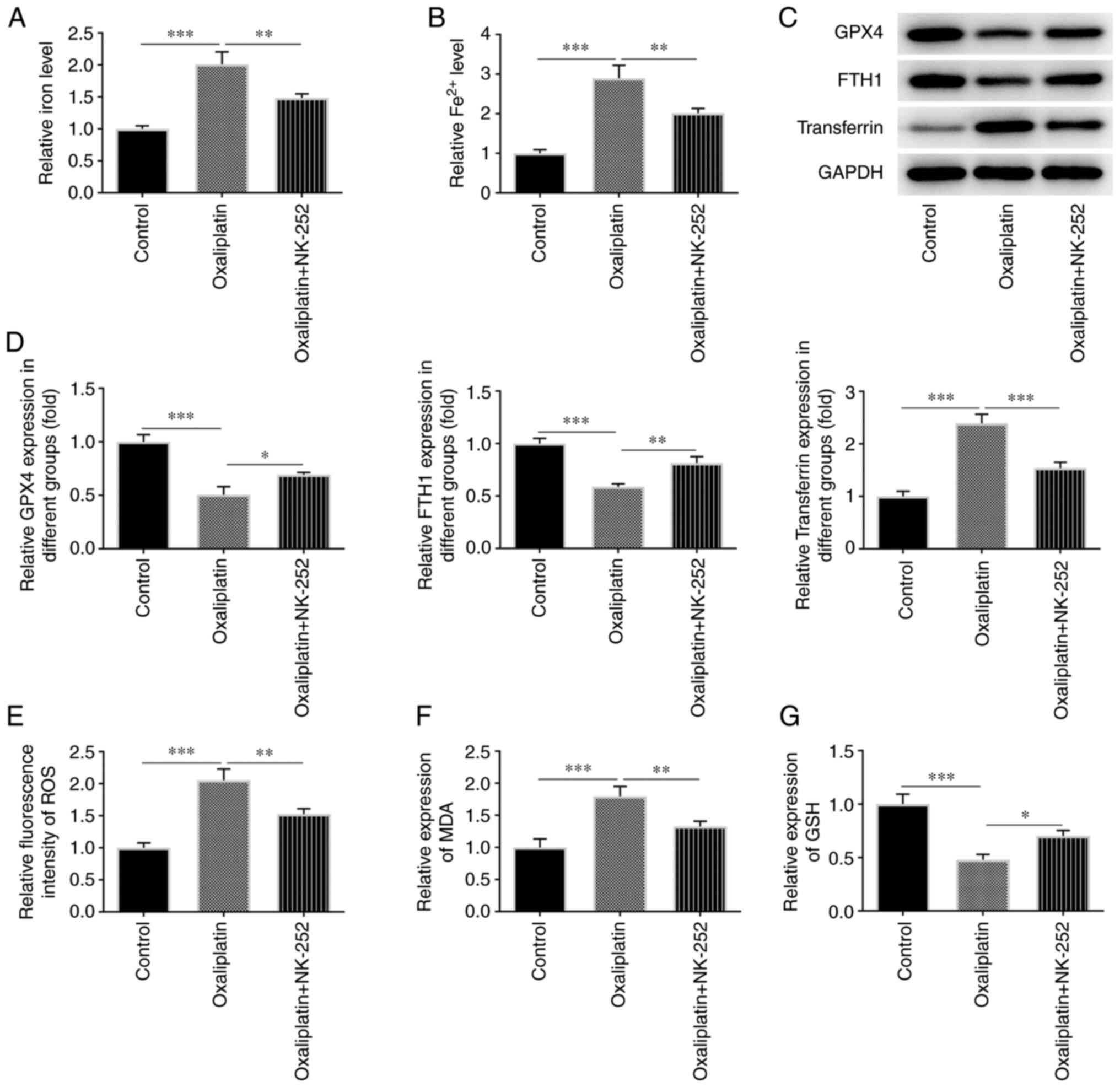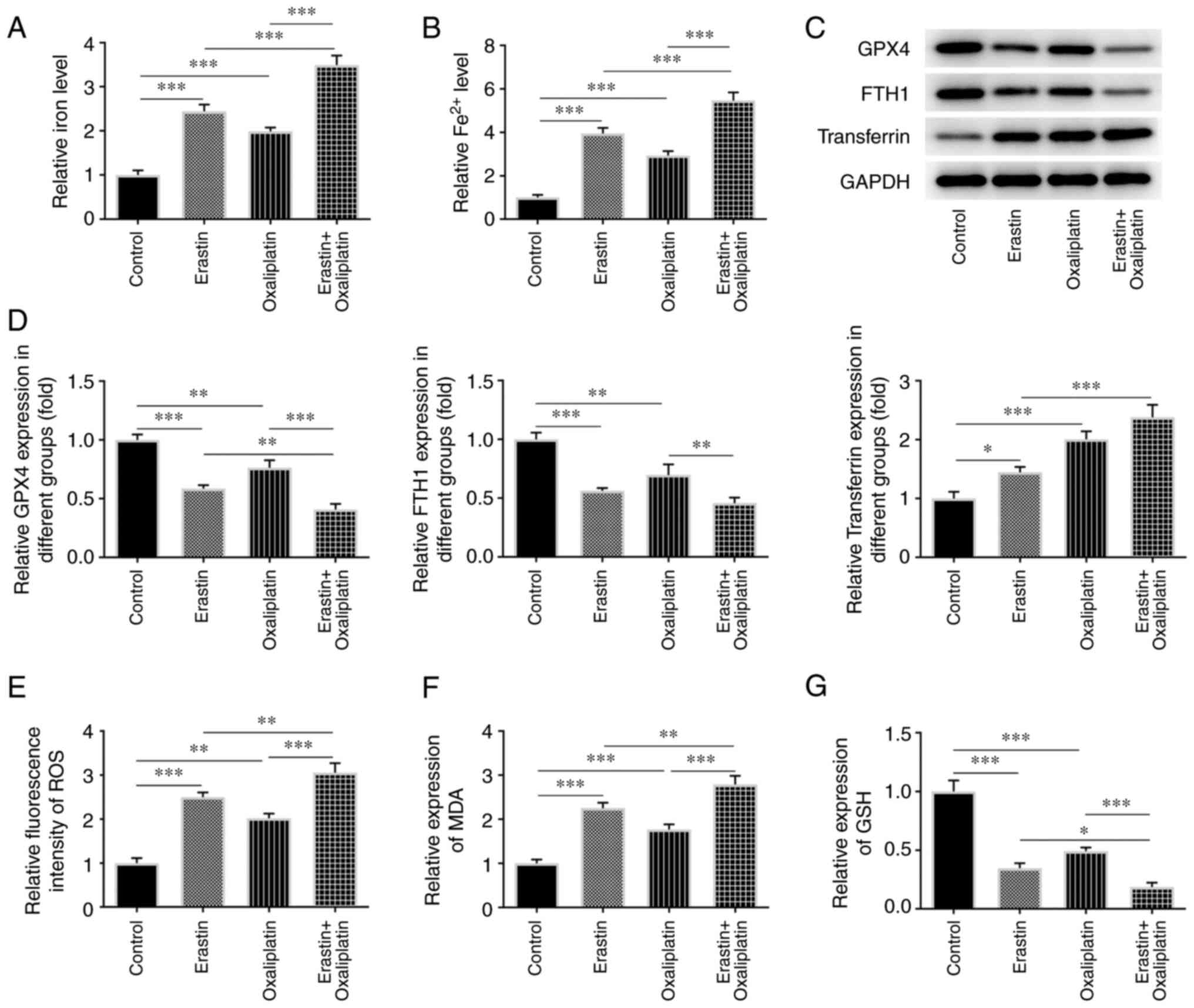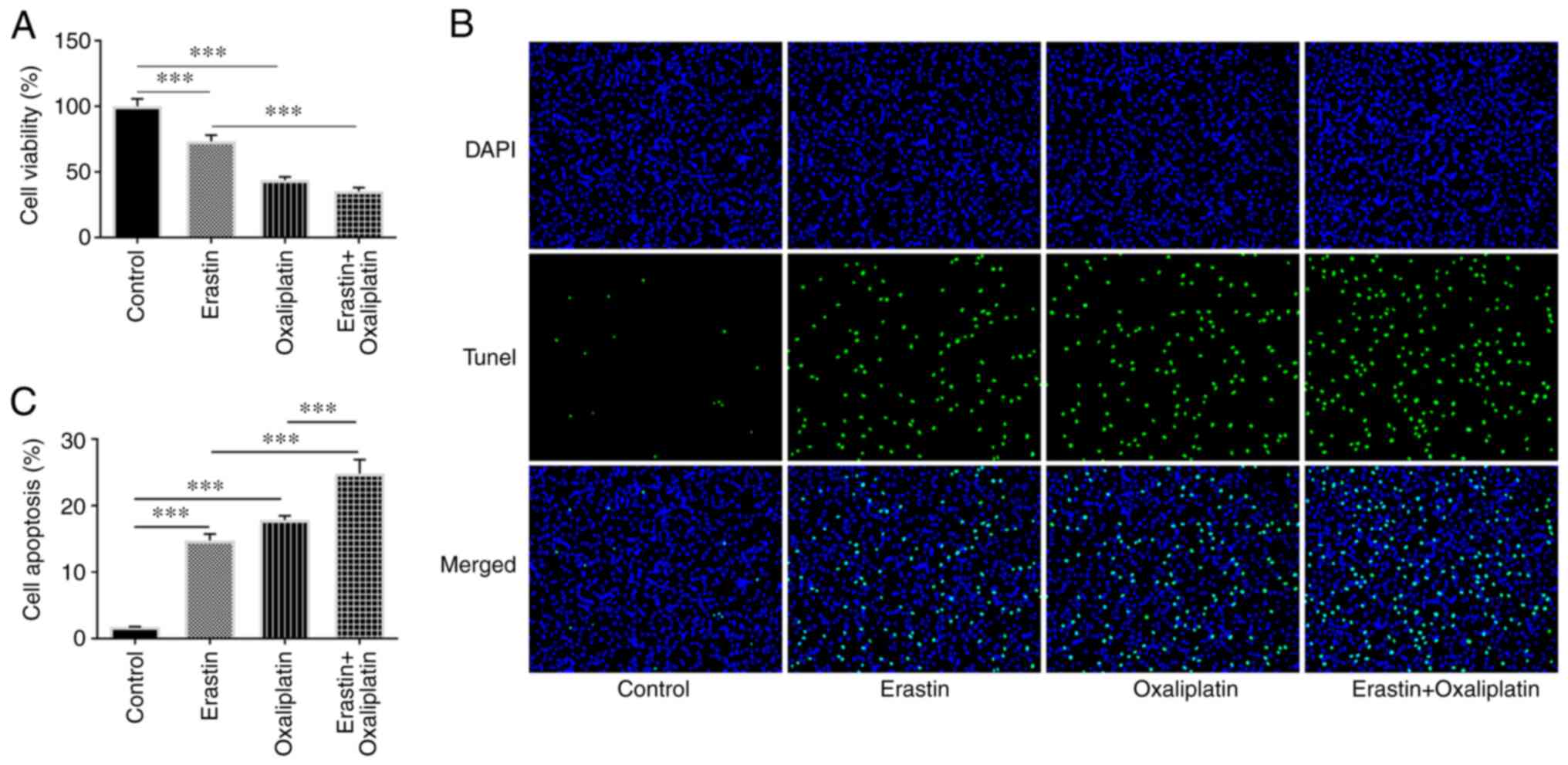|
1
|
Weitz J, Koch M, Debus J, Höhler T, Galle
PR and Büchler MW: Colorectal cancer. Lancet. 365:153–165.
2005.PubMed/NCBI View Article : Google Scholar
|
|
2
|
Pilonis ND, Bugajski M, Wieszczy P,
Franczyk R, Didkowska J, Wojciechowska U, Pisera M, Rupinski M,
Regula J and Kaminski MF: Long-term colorectal cancer incidence and
mortality after a single negative screening colonoscopy. Ann Intern
Med. 173:81–91. 2020.PubMed/NCBI View
Article : Google Scholar
|
|
3
|
Kuipers EJ, Grady WM, Lieberman D,
Seufferlein T, Sung JJ, Boelens PG, van de Velde CJ and Watanabe T:
Colorectal cancer. Nat Rev Dis Primers. 1(15065)2015.PubMed/NCBI View Article : Google Scholar
|
|
4
|
Binefa G, Rodríguez-Moranta F, Teule A and
Medina-Hayas M: Colorectal cancer: From prevention to personalized
medicine. World J Gastroenterol. 20:6786–6808. 2014.PubMed/NCBI View Article : Google Scholar
|
|
5
|
Hsu HH, Chen MC, Baskaran R, Lin YM, Day
CH, Lin YJ, Tu CC, Vijaya Padma V, Kuo WW and Huang CY: Oxaliplatin
resistance in colorectal cancer cells is mediated via activation of
ABCG2 to alleviate ER stress induced apoptosis. J Cell Physiol.
233:5458–5467. 2018.PubMed/NCBI View Article : Google Scholar
|
|
6
|
Arango D, Wilson AJ, Shi Q, Corner GA,
Arañes MJ, Nicholas C, Lesser M, Mariadason JM and Augenlicht LH:
Molecular mechanisms of action and prediction of response to
oxaliplatin in colorectal cancer cells. Br J Cancer. 91:1931–1946.
2004.PubMed/NCBI View Article : Google Scholar
|
|
7
|
Sun X, Wang X, Feng W, Guo H, Tang C, Lu
Y, Xiang X and Bao Y: Gene signatures associated with drug
resistance to irinotecan and oxaliplatin predict a poor prognosis
in patients with colorectal cancer. Oncol Lett. 13:2089–2096.
2017.PubMed/NCBI View Article : Google Scholar
|
|
8
|
Zhang F, Li F, Lu GH, Nie W, Zhang L, Lv
Y, Bao W, Gao X, Wei W, Pu K and Xie HY: Engineering magnetosomes
for ferroptosis/immunomodulation synergism in cancer. ACS Nano.
13:5662–5673. 2019.PubMed/NCBI View Article : Google Scholar
|
|
9
|
Zou Y, Palte MJ, Deik AA, Li H, Eaton JK,
Wang W, Tseng YY, Deasy R, Kost-Alimova M, Dančík V, et al: A
GPX4-dependent cancer cell state underlies the clear-cell
morphology and confers sensitivity to ferroptosis. Nat Commun.
10(1617)2019.PubMed/NCBI View Article : Google Scholar
|
|
10
|
Shin D, Kim EH, Lee J and Roh JL: Nrf2
inhibition reverses resistance to GPX4 inhibitor-induced
ferroptosis in head and neck cancer. Free Radic Biol Med.
129:454–462. 2018.PubMed/NCBI View Article : Google Scholar
|
|
11
|
Bersuker K, Hendricks JM, Li Z, Magtanong
L, Ford B, Tang PH, Roberts MA, Tong B, Maimone TJ, Zoncu R, et al:
The CoQ oxidoreductase FSP1 acts parallel to GPX4 to inhibit
ferroptosis. Nature. 575:688–692. 2019.PubMed/NCBI View Article : Google Scholar
|
|
12
|
Sang M, Luo R, Bai Y, Dou J, Zhang Z, Liu
F, Feng F, Xu J and Liu W: Mitochondrial membrane anchored
photosensitive nano-device for lipid hydroperoxides burst and
inducing ferroptosis to surmount therapy-resistant cancer.
Theranostics. 9:6209–6223. 2019.PubMed/NCBI View Article : Google Scholar
|
|
13
|
Sui X, Zhang R, Liu S, Duan T, Zhai L,
Zhang M, Han X, Xiang Y, Huang X, Lin H and Xie T: RSL3 drives
ferroptosis through GPX4 inactivation and ROS production in
colorectal cancer. Front Pharmacol. 9(1371)2018.PubMed/NCBI View Article : Google Scholar
|
|
14
|
Lu Y, Wu S, Xiang B, Li L and Lin Y:
Curcumin attenuates oxaliplatin-induced liver injury and oxidative
stress by activating the Nrf2 pathway. Drug Des Devel Ther.
14:73–85. 2020.PubMed/NCBI View Article : Google Scholar
|
|
15
|
Chian S, Li YY, Wang XJ and Tang XW:
Luteolin sensitizes two oxaliplatin-resistant colorectal cancer
cell lines to chemotherapeutic drugs via inhibition of the Nrf2
pathway. Asian Pac J Cancer Prev. 15:2911–2916. 2014.PubMed/NCBI View Article : Google Scholar
|
|
16
|
Sun X, Ou Z, Chen R, Niu X, Chen D, Kang R
and Tang D: Activation of the p62-Keap1-NRF2 pathway protects
against ferroptosis in hepatocellular carcinoma cells. Hepatology.
63:173–184. 2016.PubMed/NCBI View Article : Google Scholar
|
|
17
|
Dodson M, Castro-Portuguez R and Zhang DD:
NRF2 plays a critical role in mitigating lipid peroxidation and
ferroptosis. Redox Biol. 23(101107)2019.PubMed/NCBI View Article : Google Scholar
|
|
18
|
Singh R, Zorrón Cheng Tao Pu L, Koay D and
Burt A: Sessile serrated adenoma/polyps: Where are we at in 2016?
World J Gastroenterol. 22:7754–7759. 2016.PubMed/NCBI View Article : Google Scholar
|
|
19
|
Xiao ZM, Wang AM, Wang XY and Shen SR:
Effects of ethanol extract of radix sophorae flavescentis on
activity of colon cancer HT29 cells. Afr J Tradit Complement Altern
Med. 10:352–355. 2013.PubMed/NCBI View Article : Google Scholar
|
|
20
|
Przygodzka P, Papiewska-Pająk I,
Bogusz-Koziarska H, Sochacka E, Boncela J and Kowalska MA:
Regulation of miRNAs by Snail during epithelial-to-mesenchymal
transition in HT29 colon cancer cells. Sci Rep.
9(2165)2019.PubMed/NCBI View Article : Google Scholar
|
|
21
|
Mittag A, Schneider T, Westermann M and
Glei M: Toxicological assessment of magnesium oxide nanoparticles
in HT29 intestinal cells. Arch Toxicol. 93:1491–1500.
2019.PubMed/NCBI View Article : Google Scholar
|
|
22
|
Riddell IA: Cisplatin and oxaliplatin: Our
current understanding of their actions. Met Ions Life Sci.
18:2018.PubMed/NCBI View Article : Google Scholar
|
|
23
|
Wang W, Wang M, Xu J, Long F and Zhan X:
Overexpressed GATA3 enhances the sensitivity of colorectal cancer
cells to oxaliplatin through regulating MiR-29b. Cancer Cell Int.
20(339)2020.PubMed/NCBI View Article : Google Scholar
|
|
24
|
Limagne E, Thibaudin M, Nuttin L, Spill A,
Derangère V, Fumet JD, Amellal N, Peranzoni E, Cattan V and
Ghiringhelli F: Trifluridine/tipiracil plus oxaliplatin improves
PD-1 blockade in colorectal cancer by inducing immunogenic cell
death and depleting macrophages. Cancer Immunol Res. 7:1958–1969.
2019.PubMed/NCBI View Article : Google Scholar
|
|
25
|
Pirpour Tazehkand A, Akbarzadeh M, Velaie
K, Sadeghi MR and Samadi N: The role of Her2-Nrf2 axis in induction
of oxaliplatin resistance in colon cancer cells. Biomed
Pharmacother. 103:755–766. 2018.PubMed/NCBI View Article : Google Scholar
|
|
26
|
Yang C, Zhang Y, Lin S, Liu Y and Li W:
Suppressing the KIF20A/NUAK1/Nrf2/GPX4 signaling pathway induces
ferroptosis and enhances the sensitivity of colorectal cancer to
oxaliplatin. Aging (Albany NY). 13:13515–13534. 2021.PubMed/NCBI View Article : Google Scholar
|
|
27
|
Zhu T, Shi L, Yu C, Dong Y, Qiu F, Shen L,
Qian Q, Zhou G and Zhu X: Ferroptosis promotes photodynamic
therapy: Supramolecular photosensitizer-inducer nanodrug for
enhanced cancer treatment. Theranostics. 9:3293–3307.
2019.PubMed/NCBI View Article : Google Scholar
|
|
28
|
Roh JL, Kim EH, Jang H and Shin D: Nrf2
inhibition reverses the resistance of cisplatin-resistant head and
neck cancer cells to artesunate-induced ferroptosis. Redox Biol.
11:254–262. 2017.PubMed/NCBI View Article : Google Scholar
|
|
29
|
Shi Y, Wang Y, Huang W, Wang Y, Wang R and
Yuan Y: Integration of metabolomics and transcriptomics to reveal
metabolic characteristics and key targets associated with cisplatin
resistance in nonsmall cell lung cancer. J Proteome Res.
18:3259–3267. 2019.PubMed/NCBI View Article : Google Scholar
|
|
30
|
Zhu J, Xiong Y, Zhang Y, Wen J, Cai N,
Cheng K, Liang H and Zhang W: The molecular mechanisms of
regulating oxidative stress-induced ferroptosis and therapeutic
strategy in tumors. Oxid Med Cell Longev.
2020(8810785)2020.PubMed/NCBI View Article : Google Scholar
|
|
31
|
Basak D, Uddin MN and Hancock J: The role
of oxidative stress and its counteractive utility in colorectal
cancer (CRC). Cancers (Basel). 12(3336)2020.PubMed/NCBI View Article : Google Scholar
|
|
32
|
Shen LD, Qi WH, Bai JJ, Zuo CY, Bai DL,
Gao WD, Zong XL, Hao TT, Ma Y and Cao GC: Resibufogenin inhibited
colorectal cancer cell growth and tumorigenesis through triggering
ferroptosis and ROS production mediated by GPX4 inactivation. Anat
Rec (Hoboken). 304:313–322. 2021.PubMed/NCBI View
Article : Google Scholar
|
|
33
|
Wang J, Sun Y, Zhang X, Cai H, Zhang C, Qu
H, Liu L, Zhang M, Fu J, Zhang J, et al: Oxidative stress activates
NORAD expression by H3K27ac and promotes oxaliplatin resistance in
gastric cancer by enhancing autophagy flux via targeting the
miR-433-3p. Cell Death Dis. 12(90)2021.PubMed/NCBI View Article : Google Scholar
|
|
34
|
Dixon SJ, Patel DN, Welsch M, Skouta R,
Lee ED, Hayano M, Thomas AG, Gleason CE, Tatonetti NP, Slusher BS
and Stockwell BR: Pharmacological inhibition of cystine-glutamate
exchange induces endoplasmic reticulum stress and ferroptosis.
Elife. 3(e02523)2014.PubMed/NCBI View Article : Google Scholar
|















